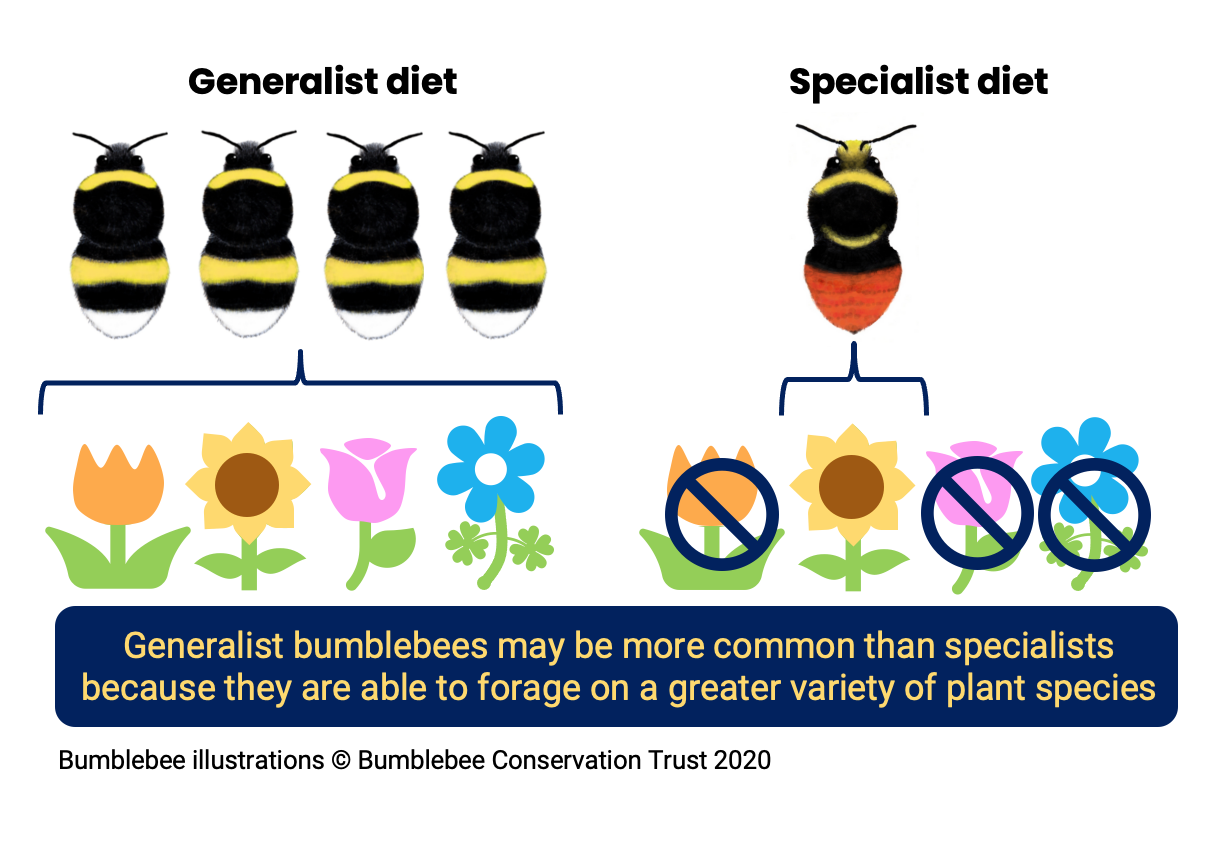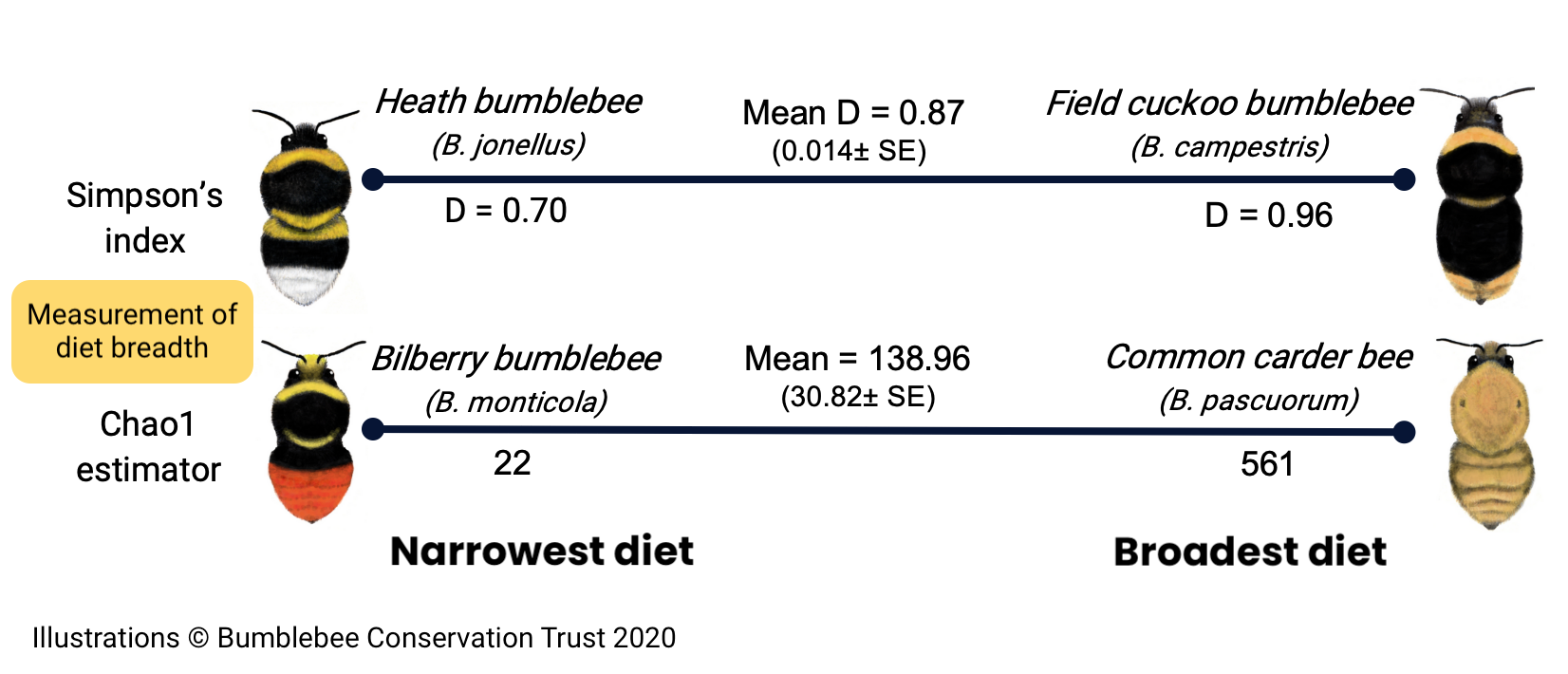Bumblebee Diets
Bumblebee Diets
Bumblebees are a charismatic group of insects as they are recognised for their important ecological role in pollination of both wild and agricultural plants. Unfortunately, after the Second World War, their numbers and geographic range declined. Whilst this is likely due to a combination of possible explanations, the leading cause is currently thought to be the intensification of farming (2–4). However, 7 of the 25 bumblebee species in the UK have shown to be more resilient against these changes and remain abundant (4,5).
The reasons behind these different rates of decline are not currently fully understood, but one possible explanation is the ‘plant-food specialisation hypothesis’ which suggests that bumblebee species that forage in a narrower range of flowers (i.e. have a more specialised diet) may be rarer than those that have a more generalist diet (6). Previous studies within relatively small areas provide mixed evidence for this hypothesis (7–9), so my study explores the relationship between British bumblebee species using multiple UK-wide datasets.
I found that the relationship between abundance/distribution and diet breadth varied depending on the method used to quantify diet breadth. The first method I used to measure diet breadth (Chao1 estimator) found that rarer species had narrower diets than more common species. However, the second method I used (Simpson’s index) disagreed and did not find the same relationship! However, rarer species are still more vulnerable to decline and extinction: especially those in isolated areas that may be prone to inbreeding (10). Rarer species may also be less likely to settle in newer habitats which could mean that isolated wildflower patches alone may be less helpful to them. Therefore, there should be a focus on creating more continuous and connected habitats if we are to also conserve the rarer bumblebee species (11).
Methodology:
• Data on abundance were taken from the latest BeeWalk report (12).
• Data on distribution were taken from the National Biodiversity Network Atlas (13).
• Data on bumblebee-plant interactions were taken from the Database of Pollinator Interactions (DoPI). The diet breadth (i.e. diversity of flowers visited) for each species were measured by calculating both a Simpson’s index and Chao1 estimator for each species (14).
• All data analysis was carried out using R version 3.6.2 (15).
This article is based on my MSc Global Biodiversity Conservation dissertation research completed over autumn 2020.
References:
1. Burkle, L. A., Delphia, C. M., and O’Neill, K. M. (2020) Redundancy in wildflower strip species helps support spatiotemporal variation in wild bee communities on diversified farms. Basic and Applied Ecology 44: 1–13. 2. Goulson, D., Lye, G. C., and Darvill, B. (2008) Decline and conservation of bumble bees. Annual Review of Entomology 53(1): 191–208. 3. Powney, G. D., Carvell, C., Edwards, M., Morris, R. K. A., Roy, H. E., Woodcock, B. A., and Isaac, N. J. B. (2019) Widespread losses of pollinating insects in Britain. Nature Communications 10(1): 1–6. 4. Foster, G., Bennett, J., and Sparks, T. (2017) An assessment of bumblebee (Bombus spp) land use and floral preference in UK gardens and allotments cultivated for food. Urban Ecosystems 20: 425–434. 5. Casey, L. M., Rebelo, H., Rotheray, E., and Goulson, D. (2015) Evidence for habitat and climatic specializations driving the long‐term distribution trends of UK and Irish bumblebees. Diversity and Distributions 21(8): 864–875. 6. Goulson, D., and Darvill, B. (2004) Niche overlap and diet breadth in bumblebees; are rare species more specialized in their choice of flowers? Apidologie 35(1): 55–63. 7. Connop, S., Hill, T., Steer, J., and Shaw, P. (2010) The role of dietary breadth in national bumblebee (Bombus) declines: Simple correlation? Biological Conservation 143(11): 2739–2746. 8. Williams, P. (2005) Does specialization explain rarity and decline among British bumblebees? A response to Goulson et al. Biological Conservation 122(1): 33–43. 9. Goulson, D., Lye, G. C., and Darvill, B. (2008) Diet breadth, coexistence and rarity in bumblebees. Biodiversity and Conservation 17(13): 3269–3288. 10. Theodorou, P., Baltz, L. M., Paxton, R. J., and Soro, A. (2020) Urbanization is associated with shifts in bumblebee body size, with cascading effects on pollination. Evolutionary Applications 00: 1-16. 11. Liczner, A. R., and Colla, S. R. (2020) One‐size does not fit all: At‐risk bumble bee habitat management requires species‐specific local and landscape considerations. Insect Conservation and Diversity 13(6): 558–570. 12. Comont, R. F., and Dickinson, H. (2020) BeeWalk Annual Report 2020. Bumblebee Conservation Trust, Stirling. Available at: https://www.bumblebeeconservation.org/wp-content/uploads/2017/05/BBCT147-BeeWalk-Report-2020-05.20.pdf [Accessed 21 October 2020].13. National Biodiversity Network (2017) National Biodiversity Network Atlas - UK’s largest collection of biodiversity information. Available through: https://nbnatlas.org/ [Accessed 27 October 2020]. 14. Balfour, N. J., Castellanos, M. C., Goulson, D., Philippides, A., and Johnson, C. (2020) DoPI: The Database of Pollinator Interactions, unpublished manuscript. University of Sussex, Brighton. 15. R Core Team (2019) R: A Language and Environment for Statistical Computing (3.6.2). R Foundation for Statistical Computing, Vienna. Available through: https://www.R-project.org/ [Accessed 02 January 2021].


